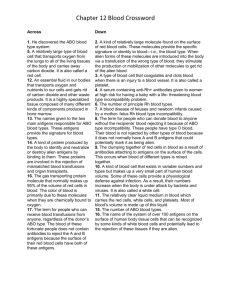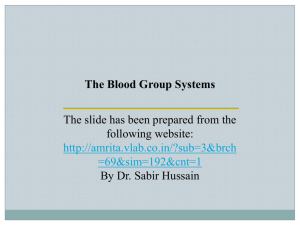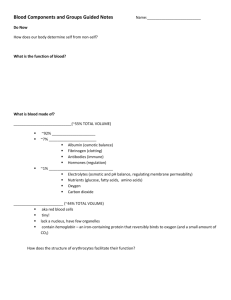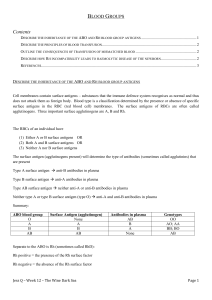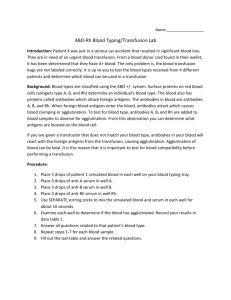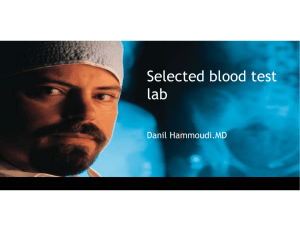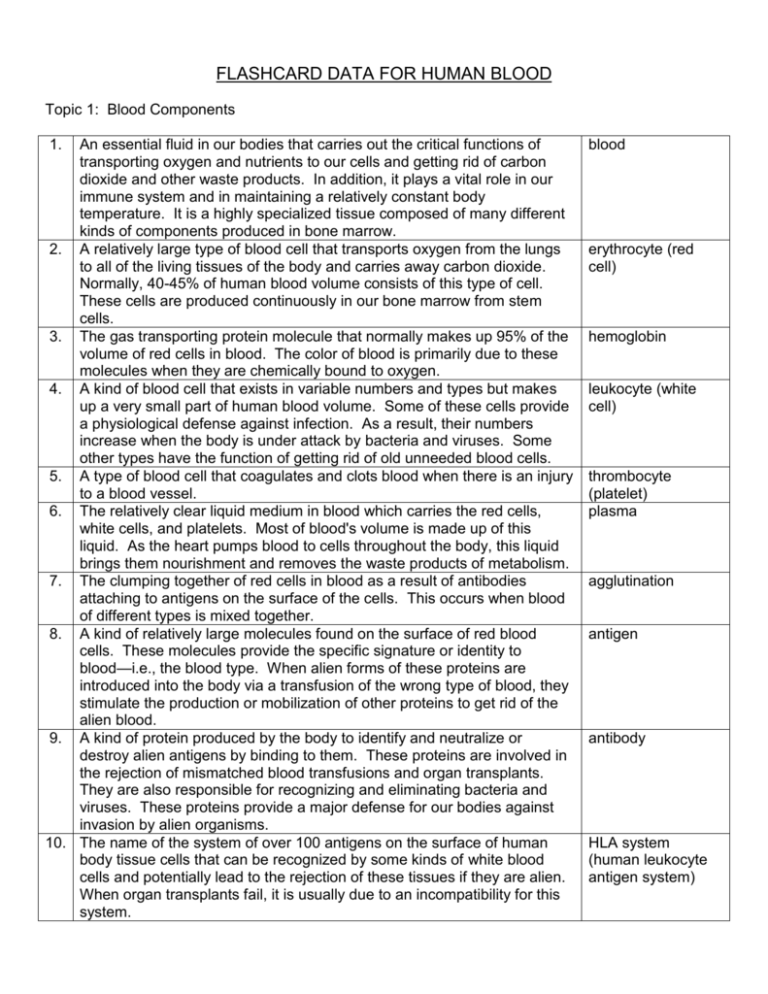
FLASHCARD DATA FOR HUMAN BLOOD
Topic 1: Blood Components
1.
An essential fluid in our bodies that carries out the critical functions of
transporting oxygen and nutrients to our cells and getting rid of carbon
dioxide and other waste products. In addition, it plays a vital role in our
immune system and in maintaining a relatively constant body
temperature. It is a highly specialized tissue composed of many different
kinds of components produced in bone marrow.
2. A relatively large type of blood cell that transports oxygen from the lungs
to all of the living tissues of the body and carries away carbon dioxide.
Normally, 40-45% of human blood volume consists of this type of cell.
These cells are produced continuously in our bone marrow from stem
cells.
3. The gas transporting protein molecule that normally makes up 95% of the
volume of red cells in blood. The color of blood is primarily due to these
molecules when they are chemically bound to oxygen.
4. A kind of blood cell that exists in variable numbers and types but makes
up a very small part of human blood volume. Some of these cells provide
a physiological defense against infection. As a result, their numbers
increase when the body is under attack by bacteria and viruses. Some
other types have the function of getting rid of old unneeded blood cells.
5. A type of blood cell that coagulates and clots blood when there is an injury
to a blood vessel.
6. The relatively clear liquid medium in blood which carries the red cells,
white cells, and platelets. Most of blood's volume is made up of this
liquid. As the heart pumps blood to cells throughout the body, this liquid
brings them nourishment and removes the waste products of metabolism.
7. The clumping together of red cells in blood as a result of antibodies
attaching to antigens on the surface of the cells. This occurs when blood
of different types is mixed together.
8. A kind of relatively large molecules found on the surface of red blood
cells. These molecules provide the specific signature or identity to
blood—i.e., the blood type. When alien forms of these proteins are
introduced into the body via a transfusion of the wrong type of blood, they
stimulate the production or mobilization of other proteins to get rid of the
alien blood.
9. A kind of protein produced by the body to identify and neutralize or
destroy alien antigens by binding to them. These proteins are involved in
the rejection of mismatched blood transfusions and organ transplants.
They are also responsible for recognizing and eliminating bacteria and
viruses. These proteins provide a major defense for our bodies against
invasion by alien organisms.
10. The name of the system of over 100 antigens on the surface of human
body tissue cells that can be recognized by some kinds of white blood
cells and potentially lead to the rejection of these tissues if they are alien.
When organ transplants fail, it is usually due to an incompatibility for this
system.
blood
erythrocyte (red
cell)
hemoglobin
leukocyte (white
cell)
thrombocyte
(platelet)
plasma
agglutination
antigen
antibody
HLA system
(human leukocyte
antigen system)
Topic 2: ABO Blood Types
Topic 3: Rh Blood Types
1.
The man who discovered the ABO blood type system in 19001901 at the University of Vienna. Thirty years later, he belatedly
received the Nobel Prize for this discovery that explained why
blood transfusion sometimes killed the patient receiving them.
2. The names of the 4 ABO blood types.
3. The names given to the two main antigens responsible for ABO
blood types. These antigens provide the signature for blood
types.
4. The names given to the two main antibodies responsible for
rejecting blood of an alien ABO type.
5. The term for people who can donate blood to anyone without the
recipients’ blood rejecting it because of ABO type incompatibility.
These people have type O blood. Their blood is not rejected by
other types of blood because it does not normally have A and B
antigens that could potentially mark it as being alien.
6. The term for people who can receive blood transfusions from
anyone, regardless of the donor’s ABO type. The blood of these
fortunate people does not contain antibodies to reject the A and
B antigens because the surface of their red blood cells have
both of these antigens.
7. The situation in which a mother's blood type is different from that
of her unborn child. In the case of some combinations of types,
the mother's blood system can produce antibodies to antigens
on the surface of the red cells of her fetus resulting in their
agglutination.
8. The names of the two principle Rh blood types.
9. A blood disease of fetuses and newborn infants caused by a
mother-fetus Rh blood type incompatibility. Specifically, the
mother's anti-Rh+ antibodies agglutinate her infant's Rh+ blood.
Symptoms include life threatening anemia, jaundice, fever,
swollen tissues from edema, and an enlarged liver and spleen.
Serious cases of this condition are treated by fetal blood
replacement.
10. A serum containing anti-Rh+ antibodies given to women at high
risk for having a baby with erythroblastosis fetalis (i.e., Rhwomen with Rh+ mates).
Copyright © 2007-2012 by Dennis O'Neil. All rights reserved.
Karl Landsteiner
A, B, AB, and O
A and B antigens
anti-A and anti-B antibodies
universal blood donor
universal blood receiver
mother-fetus incompatibility
Rh+ and Rherythroblastosis fetalis
Rho-GAM


